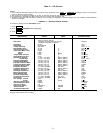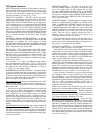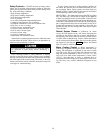
Safety Controls — The PIC monitors all safety control
inputs, and if required, shuts down the chiller or limits the
guide vanes to protect the chiller from possible damage from
any of the following conditions:
• high bearing temperature
• high motor winding temperature
• high discharge temperature
• low oil pressure
• low cooler refrigerant temperature/pressure
• condenser high pressure or low pressure
• inadequate water/brine cooler and condenser flow
• high, low, or loss of voltage
• excessive motor acceleration time
• excessive starter transition time
• lack of motor current signal
• excessive motor amps
• excessive compressor surge
• temperature and transducer faults
Starter faults or optional protective devices within the starter
can shut down the chiller. These devices are dependent on
what has been purchased as options.
If compressor motor overload occurs, check the motor
for grounded or open phases before attempting a
restart.
If the controller initiates a safety shutdown, it displays
the fault on the LID display with a primary and a secondary
message, and energizes an alarm relay in the starter and blinks
the alarm light on the control center. The alarm is stored in
memory and can be viewed in the PIC alarm table along with
a message for troubleshooting.
To give a better warning as to the operating condition of
the chiller, the operator also can define alert limits on vari-
ous monitored inputs. Safety contact and alert limits are
defined in Table 3.Alarm and alert messages are listed in the
Troubleshooting Guide section, page 66.
SHUNT TRIP— The shunt trip function of the PIC is a safety
trip. The shunt trip is wired from an output on the SMM to
a shunt trip-equipped motor circuit breaker. If the PIC tries
to shut down the compressor through normal shutdown pro-
cedure but is unsuccessful for 30 seconds, the shunt trip out-
put is energized and causes the circuit breaker to trip off. If
ground fault protection has been applied to the starter, the
ground fault trip will also energize the shunt trip to trip the
circuit breaker.
Default Screen Freeze — Whenever an alarm
occurs, the LID default screen will freeze displaying the
condition of the chiller at the time of alarm. Knowledge of
the operating state of the chiller at the time an alarm occurs
is useful when troubleshooting. Current chiller information
can be viewed on the Status tables. Once all existing alarms
are cleared (by pressing the RESET
softkey), the default
LID will return to normal operation.
Motor Cooling Control — Motor temperature is
reduced by refrigerant entering the motor shell and evap-
orating. The refrigerant is regulated by the motor cooling
relay. This relay will energize when the compressor is run-
ning and motor temperature is above 125 F (51.7 C). The
relay will close when motor temperature is below 100 F
(37.8 C). Note that there is always a minimum flow of
refrigerant when the compressor is operating for motor cool-
ing; the relay only controls additional refrigerant to the
motor.
29


















